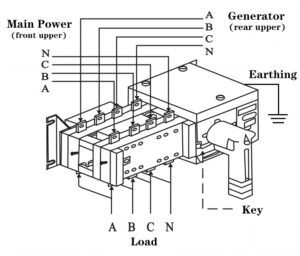A properly wired changeover switch keeps your house or business safe, functioning, and powered with as little interruption as possible when the power goes out unexpectedly.
You’re not the only one who has ever questioned how to safely combine utility and generator electricity. We’ll not only show you how to wire a changeover switch in this article, but we’ll also talk about the best ways to install an Automatic Transfer Switch (ATS) to make sure it works well and is as safe as possible.
How to Wire a Changeover Switch with Three Phases
If your wiring isn’t right, power outages can be annoying, cause downtime, and even harm your equipment. A correctly installed changeover switch fixes this by letting you switch between power sources without any problems.
We will use this three-phase, dual-power automatic transfer switch as an example to show how to wire it.

The upper terminals in the front connect to the Main power, the upper terminals in the back connect to the generator, and the lower terminals link to the load. For safety, grounding and parallel connections are necessary.
Important Steps for Wiring
- Find the four terminals: L1, L2, L3, and N.
- Attach the upper front terminals to the power supply.
- Connect the upper rear terminals to the generator.
- Connect the load to the bottom terminals.
- Connect the upper and lower terminals in parallel.
- Make sure the switch body is grounded.
- Connect the load terminals to the main line that comes in.
This systematic method not only makes sure that things work, but it also stops expensive blunders like sending power back into the grid, which might put lives and property at risk.
Important Things to Think About When Installing Automatic Transfer Switches (ATS)
A lot of installs fail not because of bad wiring, but because people forget important elements. Installing ATS isn’t as simple as just connecting wires; it also requires rigorous adherence to safety and performance criteria.
Follow electrical codes, choose the right enclosures, size feeders correctly, give overcurrent protection, make sure the neutral and ground connections are accurate, confirm phasing, and test functionality frequently to set up a safe ATS.
Important Rules
- Put ATS next to the loads to keep cable runs short.
- Choose the right sort of enclosure for the space and the surroundings.
- Check that the feeders are within the limitations for ampacity and voltage loss.
- For each source and load, use a different conduit.
- According to NEC, use overcurrent protection on all sides.
- Use rated bus bars for the ground, phase, and neutral.
- Don’t use shared neutrals, and make sure your grounds are connected correctly.
- Use the right amount of torque for connections.
- Use breaker interlocks to stop paralleling.
- Set up extra control circuits for sensing and starting/stopping.
- Check the voltages, rotation, and phasing before testing.
- Do a full set of functional tests.
- Do frequent checks and maintenance.
By following these best practices, you not only make sure that you follow NEC and manufacturer rules, but you also make a system that can handle real-world needs.
In conclusion
Putting in and wiring a changeover switch or ATS is more than just a technical job; it’s a way to make sure that your electricity stays on all the time. You can reduce dangers, preserve equipment, and ensure long-term performance by following explicit wiring instructions for three-phase switches and stringent ATS installation rules. These steps will help you feel ready for power outages, whether they are for your home or for important business activities.



